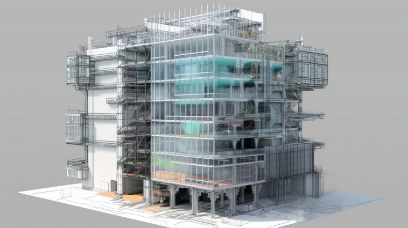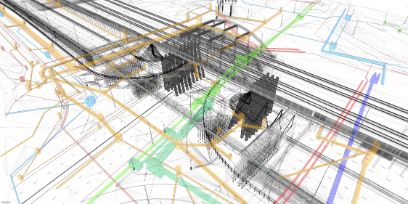- Story
Digital construction starts in the mind
03.10.2023 Digital building is about rethinking. Instead of solving problems reactively and at the last moment on the construction site, it is done proactively with the digital model. The 6-point plan of BFH lecturer Adrian Wildenauer helps with his rethinking.
Digital construction – mostly with the help of building information modelling (BIM) – currently challenges many tried-and-tested processes in the construction industry. That is because digital construction happens first in the mind and on the computer, where a virtual model of the project is created.
Many decisions can already be made and potential problems eliminated on the basis of this very details 3D image of the later structure. The proponents of this new, digitally-supported type of construction promise efficiency gains and quality improvement, less construction errors, and greatly simplified construction logistics.

Rethinking comes before rebuilding
However, the transformation from analog to digital construction is anything but straightforward. BFH lecturer Adrian Wildenauer knows this from his own experience. As a civil engineer, he knows the construction industry in all its facets, from reinforcing bars to BIM modelling.
For SBB, he has developed an industry-wide 6-point plan to serve as a basis for rethinking construction from analog to digital. In his view, it is crucial that all stakeholders in the construction industry participate and work together to drive the industry forward.
1 Clarify goal and roadmap
In digital construction, the basics, roadmaps, models and the target vision are available to all participants right from the start. This allows construction companies, suppliers, architects and clients to coordinate long before the groundbreaking ceremony and eliminate potential conflicts and sources of error at an early stage. “We must involve all stakeholders in the value chain,” emphasises Adrian Wildenauer.
2 Communicate with language
Digital construction projects rely on everyone speaking the same language. The industry achieves this by working even more closely with valid standards. Starting with relevant terms of digital construction, the standards of the Swiss Society of Engineers and Architects (sia) or the Competence Centre for Standards in the Construction and Real Estate Industry (crb), to communication with the industry-relevant federations and associations: especially in the beginning, it is important that everyone involved understands each other. The National Glossary, the terms of which were defined in common, also helps here.
We must involve all stakeholders in the value chain.

3 Communicate with data model
The people but also the systems involved rely on an effective communication. Because a virtual model of the construction project is central to digital construction, a consolidated data model must be developed jointly. This allows information to be exchanged easily, from the planner to the supervisor. “Dealing with data is our common new language. We have to learn it,” stresses Adrian Wildenauer.
4 Reuse components
One advantage of digital construction is that you do not necessarily have to reinvent the wheel with every new building project. After all, many elements of a construction come back with every project. Instead of designing, sizing and assessing them from scratch, as has been done in the past, standardised building objects can be used. For example, before you design a door, you build a standardised digital model of it. This includes all the necessary attributes from the choice of materials to the cylinder size, widths and heights of the door leaves and sealing strips. Such standardised construction objects help companies save time and avoid mistakes. For this to work, companies need an easy access to a collection of such digital components.
Dealing with data is our common new language. We have to learn it.

5 Gain experience
Knowledge transfer in the construction industry is often still very traditional, passing directly from the experienced supervisor to the apprentices on the site. In digital construction, this knowledge, which is intangible or undocumented at present, can be systematically collected on the construction site and used for training. But the experience with digital construction itself can also be recorded and the digital tools and processes assessed for their suitability. If digital construction management leads to better knowledge transfer, the industry is on the right track. Adrian Wildenauer is convinced: “Only by sharing knowledge can we succeed together.”
6 Teach ordering basics
Many processes in digital construction culminate in an order, be it with the booking of a service or the purchase of materials. A major advantage of digital construction is that the data required for orders is recorded at an early stage in the virtual model of the project. But for anything to happen on the job site, everyone involved in the project must know how to obtain and apply order data from the system. Appropriate training and documentation for employees is therefore mandatory.

Only by sharing knowledge can we succeed together.

Practice shows that digital construction requires a joint, digital cooperation. Systems and IT infrastructure are important, but not until architects, civil engineers and partner companies are ready to collaborate across their areas of expertise. After all, digital construction does not start on the screen but in the minds of the professionals.
